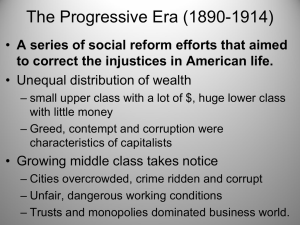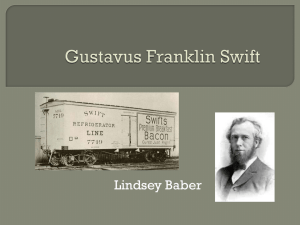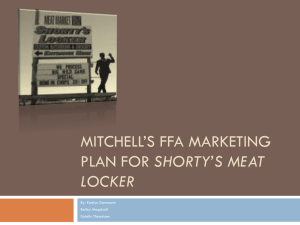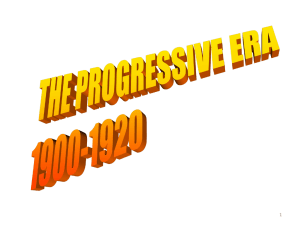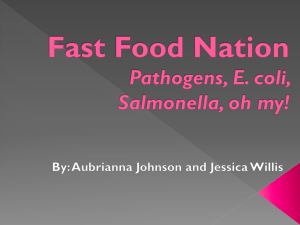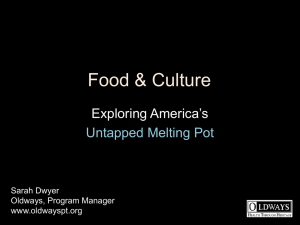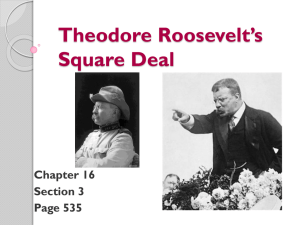The History of official meat controls
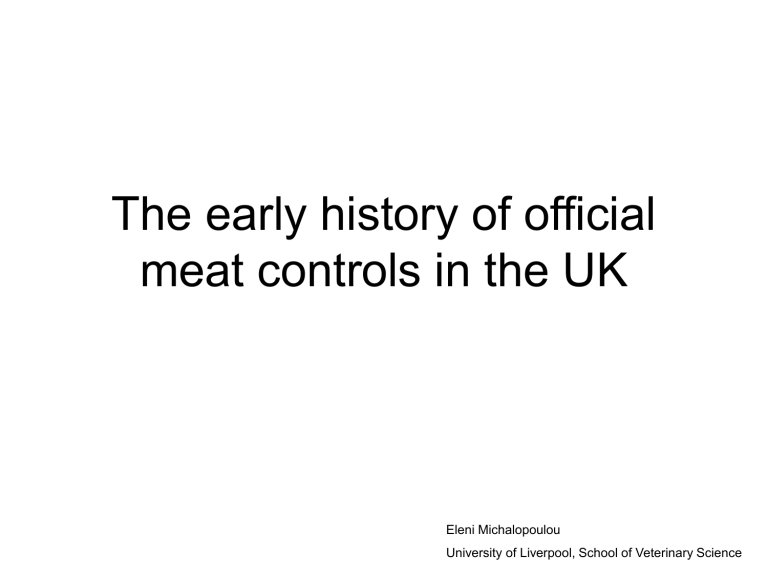
The early history of official meat controls in the UK
Eleni Michalopoulou
University of Liverpool, School of Veterinary Science
19
th
Century: a case
1857 Session 2 [2233] Report on Murrain in
Horned Cattle, Public Sale of Diseased Animals, and Effects of Consumption of their Flesh on
Human Health, by E.H. Greenhow
“These butchers are there described as persons who purchase and kill diseased cows and other animals…. The meat is chiefly sold to the proprietors of stew and pie shops, but also partially retailed to the poorer classes….”
Nuisances removal and disease prevention Act 1855
• Addresses the sale of meat unfit for human consumption;
• The act made obligatory the employment of one or more
"sanitary inspectors"
(previously inspectors of nuisances) by each authority or jointly with other authorities;
• Defined their powers of entry
Nuisances removal and disease prevention Act 1855
Mid19
th
century: the context…
• Industrial Revolution and liberalisation of trade
• Urbanisation
– Poor Law amendment Act 1832
• Epidemics
– Cholera
– TB
– FMD: 1839
–
CBPP
– Phytophthora infestans (Potato blight)
• Sanitary movement and first legislation
– Engels, Chadwick, Snow
• Miasma v contagion
• Political change:
– The Great Reform Act 1832
– The People’s Charter 1838
–
1848 Revolutions in Europe
• 1855: "Recherches sur la Putrefaction" by
Luis Pasteur
Nuisances Removal and Disease
Prevention Act 1855
•
Trade in meat from diseased animals is at the centre of Inspectors’ enforcement when and where it is applied
• John Gamgee estimated that around 20% of all meat consumed in the UK in the 1850s and1860s was from diseased animals (predominantly FMD and CBPP)
•
Newton Heath had 16 abattoirs of which 3 specialised in the slaughter of diseased animals
•
The Inspector for Leads:
– 1861: 798 submitted, 305 rejected
– 1864: 1,414 submitted, 547 rejected
– The diseased meat not sent through Leads….
Nuisances Removal and Disease
Prevention Act 1855
•
The implementation of the Act was not uniform or compulsory for the Local Authorities. Not enough inspectors were appointed (Birmingham had only one)
• There is no specific training
•
Butchers, Farmers, Cattle dealers and dairymen fought against the implementation of the Act (e.g.
Smithfield Market relocation: 1828-1855, pubs, butchers and St Bart’s)
• The links between diseased animals and human disease is not based on knowledge of aetiology but observation and occasionally “experimental” studies
The Buildings Act 1844
• No slaughterhouse within 50 feet of a dwelling and 40 feet of a public way with a 30 year period of grace…
• “Remembered” in 1873, it would have led to the closure of private abattoirs
• The House of commons Select Committee on Noxious
Businesses recommended the repeal of the relevant clauses of the Act
The Public Health Act 1875
Gradual implementation:
• At the end of the 1870’s 689 district in England and Wales had at least byelaws for the sale and slaughter of meat while 205 did not
• In 1896 From 249 Meat inspectors Nationally 191 were in London and 13 in Glasgow
Tuberculosis
• Dominates the discussion about animal and human disease
– Confusion over transmissibility of M. bovis to humans
– Long debate over the role of meat in transmission and the need for whole carcass condemnation
• Unsafe meat begins to get specific descriptions
• The debate on the need for 100% inspection and public abattoirs continues
1898: 2nd Royal Commission on
Tuberculosis
• Recognises TB as a zoonosis transmitted by food with particular reference to milk (R. Koch will later challenge this statement, 3 rd
Comission)
• Suggests that the use of the meat from diseased animals if not directly affected may be consumed
• Recommends cooking of meat and boiling of milk
• Recommends the creation of Public slaughterhouses under the supervision of the local authority and the closure of the private ones
• Recommends the technical training of Meat inspectors.
Results…
•
The Sanitary Institute produces a syllabus and a course that provides a qualification in
Meat Inspection. By 1903 107 “graduate” among them Vets, Sanitary inspectors, butchers and salesmen.
• TB is a major disease that is detected through meat inspection but by now included in the list of the inspector are: Anthrax,
Actinomycosis, Cysticercus Cellulosae, Liver fluke, braxy, Trichinella Spiralis , and the animal diseases of FMD, CBPP and
Rindrpest
• Beyond the role of specific conditions the hygiene of meat and the role of contamination is also recognised
J. Lane Notter MD DPH and W. Hunting FRCVS (1904)
Results…
• Public abattoirs are not introduced in any systematic way
• Questions are raised for even their standards
Mr Wolstenholme of Manchester MRCVS
From the discussion at the conference of veterinary inspectors in Manchester 1904
Results…
• Inspection is not universal and unfit meat still available
International Meat Trade
•Average amount of Meat consumed per annum in the UK:
– 1831-1841: 980,000 tons 100% domestic
– 1910-1914: 2,575,400 tons 58% domestic 42% imported (Perren 1978)
•Controls for live animals date back in the 1860s
•Up to 1906 only London Port Authorities had the power to inspect Imports.
•The Manchester Port Order is amended to include such powers in 1906 under public pressure (Chicago, “Jungle”)
• Public Health (Regulations as to Food) Act 1907
– Powers of sampling for testing and detention, £100 penalty for disobeying..
– Different classes of meat (early “risk assessment”)
“Uniformity of Inspection and
Seizures”
• 1920 National Federation of Meat Traders requests measures for
“Uniformity of Inspection and Seizures”
• 1875 PH Act (1890 Amend.) is the law
• London and Scotland have their own additional rules where slaughterhouses need to be licensed
• Scotland in addition had rules for emergency slaughter
• The Medical Officer of Health and the Inspector of Nuisances (Sanitary
Inspector) are the legally powered officers. In Scotland in addition the
Veterinary Surgeon is an authorised officer
• Inspection is becoming part of the within trade competition
“Uniformity of Inspection and
Seizures”
• During the war compensation for the meat trade was introduced for diseased animals (compulsory allocation of animals)
• The Monro Enquiry reported in 1921 and led to the:
– Memo 62/Foods (1922)
– The Public Health (Meat) Regulations 1924 (and in Scotland)
– The Rural District (Slaughterhouses) Order (1924)
• Detailed rules for Meat Inspection, reporting system for diseases
• The rules were adoptive and some LA did not implement them
• 20,000 private slaughterhouses in 1927
No Changes until 1958…
• With the exception of the creation in 1938 of the Animal Health division of MAF with responsibility in Animal Health (subsequently
State Veterinary Service/AH/AH-VLA)
• In 1937 LAs employed 200 full time and 700 part time Vets. After the change Vets remained in Scotland and N. Ireland but not in England and Wales
• At the end of rationing there were 500 slaughterhouses in England and Wales. They rose to 4,500 by the early 60’s
1958-19641970’s-1995-2004
• From the Domestic and Import controls to the Common market and globalised trade (WTO)
• Upgrade of the role of hygiene and structural standards
• From Local to Centralised controls (though not for all aspects…)
• From TB to Salmonella/BSE/ Campylobacter / E.coli
…..
• The “battle” continues….
Selected sources and acknowledgments
•
The Journal of the Royal Society for the Promotion of Health
• Animal Health a Centenary, 1865-1965
•
Food, Science, Policy and Regulation in the 20 th
Century D.F. Smith and J. Phillips Eds.
•
The Meat Trade in Britain 1840-1914 by Richard
Perren (1978)
• The Glasgow case: Meat,disease and regulation
1889-1924
• The development of Veterinary Public Health in
Western Europe 1850-1940 P. Koolmees
• Professional Advantage and Public Health: British
Veterinaruians and State Veterinary Services, 1865-
1939
•
The Science of Cows: Tuberculosis, Research and the State in the UK, 1890-1914
•
My colleagues at the VPHA
•
All of you for listening
